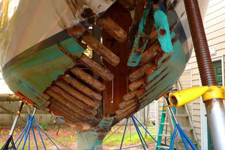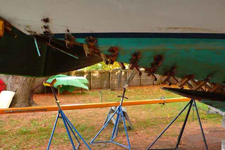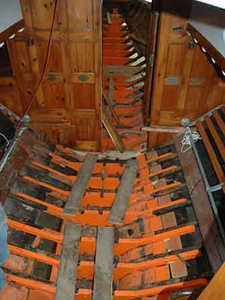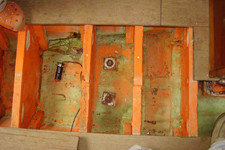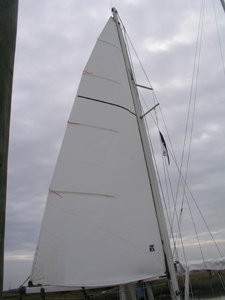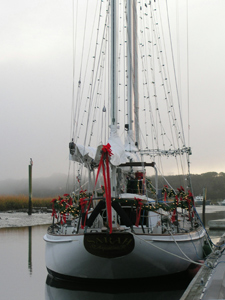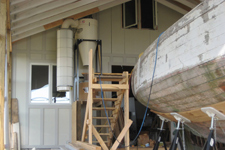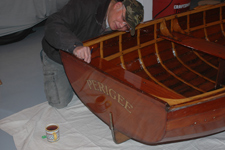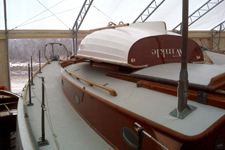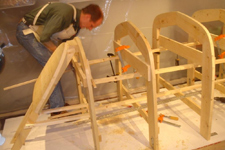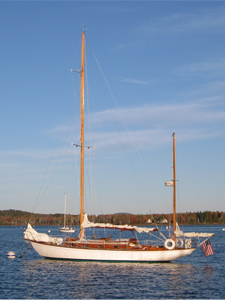The Concordian
Issue #47, Spring 2009
From the Editor's Desk
Welcome to your new newsletter!

I am very excited to be able to take The Concordian to yet another level. Several factors contributed to the new format. First, all but a couple of owners responded to my 'hey ya' haven't paid in a while ...' notes, and most anted up for prior years transgressions. The few that I didn't hear from I suspected weren't interested, or in one case is a business address and I doubt the newsletter even lands on the right person's desk.
As the owner of a classic wooden boat, I am hardly a paragon of good financial management, but it was getting a bit old doing the newsletter and covering the shortfall when it came to toner and postage, but thanks to all of the folks that caught up on their subscriptions, we're in the black for the second time in four years.
In fairness to the folks who do pay for their subscriptions, the handful that didn't respond have been dropped from the mailing list. If you're reading this, you're in good standing!
The second factor is that I have taken over our yacht club newsletter and in doing so have upgraded some of my software as well as received some pointers from several folks in the graphic arts business. I'm looking forward to applying my new-found knowledge to both newsletters.
One thing that will be a factor from this point forward is that this printing style calls for the newsletter to be some combination of four pages - 4, 8, 12, 16, etc. When I printed it myself, it was easy to just print whatever was sent in. I encourage everyone to continue to contribute whatever they want, but know that I may have to reach out to you and let you know that for space considerations your piece may need to be a little shorter, or maybe use one less picture.
It is also possible that a contribution would need to be a little longer. One of my YC officers was just tickled when I asked him to add a couple of paragraphs to his piece. He said it was the first time someone had asked him to say more instead of less...
For this issue I was able to include all but a couple of pictures that were sent in (sorry Jim...), but the writers that look closely at their pieces may notice some spaces added between paragraphs or maybe paragraphs were combined just to make things fit.
This issue is a little late getting to the printers, and I have no real excuse. Each issue has gotten easier and easier to put together and this format really makes it a breeze! I just waited until the last minute, and then - no surprise - had some other things come up and monopolize my time.
I'll do better in the fall. I promise.
For now - Enjoy!
Concordia Company
South Dartmouth, MA
Happy Spring from Concordia Company, Inc. We are excited about warmer weather and covers coming off. We have three yawls in the water already, one with spars in and ready to sail, and six more in the queue (today is April 15th). We have two "inactive" boats here, and a third taking a season off. Several of our boats had some plank replacements. A few others had interior paint and varnish upgrades. Snowy Owl had the biggest refit, totaling 21 new full-length planks below the waterline. Additionally we scarfed in 8 frame ends, repainted the sole (original spackle), and replaced the table legs and brackets.
We are thrilled with our new storage shed. It allowed us to bring yawls out and into our workshop for projects and then easily back in for storage. The boats stayed quite tight which is obviously the most important thing. Get in touch with Brodie (ramacgregor@concordiaboats.com) if you have any interest in buying a yawl or if you know someone who might. With the soft economy, there hasn't been a better time to buy a yawl.
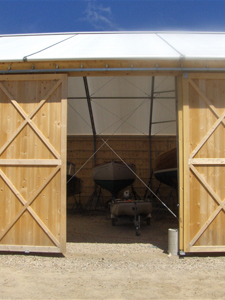
Looking forward, and at the calendar, we will add the Newport International Boat Show (September 17th to 20th) to our routine this year. We’ll continue to have a presence at the WoodenBoat Show in Mystic (June 26th to 28th). Really the goal is to keep generating new prospective storage and service customers and wooden boat owners. We also have our 3rd Annual Open House on Saturday September 19th from 1 – 8. Finally, several owners are considering racing in the New Bedford Yacht Club’s Whalers Race which is Saturday, September 12th. The course is South, out around Nomans, West, around Block Island, and then Northeast back into Buzzards Bay and Padanaram. We hope to see you this season.
Golondrina #65
John Eide, Portland, ME
Maine winters are too long which means that the commissioning season is way too short. I finally unwrapped Golondrina on April 14 and immediately started putting the bottom back on. Rather than retell my Fall tale, take a look at the photos to see what I wrote about. These photos show the space left by rotten gripe, or forefoot, along with the floor timbers.
The third photo was taken five days later, just before the cold settled in to make working outside impossible. That's the way she sat over the winter. My goal is to get the bottom on by May 1 while Jud, the wannabe boat builder who's helping me, works on reinstalling the interior. Then we have a new array of electronics to install along with upgrading the alternator, battery banks and monitoring system. What I didn't mention in my fall letter is that almost all the old electronics on Golondrina died, one by one, during last summer. So I might as well bring all that gear up to date while I'm doing the structural work.
Since my question in the last newsletter, I made some inquiries about the issue of the white chalky material in the area of the floor timber bolts and the discovery that the washers under the iron nuts were bronze. If you look at this photo, you can see the oval areas that never held paint and hints of the white powder. Three boat builders, a surveyor and an expert on marine systems and galvanic corrosion all chimed in and the consensus is that a galvanic reaction is taking place between the iron, the bronze and the oak leading to the breakdown of the oak, called delignification.
None of them could believe that anyone at A&R would pull such a trick, but someone did. So, if you see a similar condition on your boat, douse the area with white vinegar to slow down the action and head to your favorite boat yard to have the problem corrected. I still have available an original, c1955, Concordia cabin heater, never installed in a boat, cleaned, recaulked, and freshly blackened. Like new.
Enough. Back to work. See you on the water.
John Eide
Golondrina
Saxon #14
Craig & Marcia Steidle, Annapolis, MD
Although Craig had been aware of Concordia yawls for quite some time, I had never seen one before until our son-in-law, Andrew Wallace, of Traditional Boatworks pointed out Arapaho at the Wooden Boat Show in Mystic, CT the summer of 2007. She was the most beautiful sailboat I had ever seen! We immediately began a quest to find one available for purchase and very shortly afterward bought Saxon. Saxon had belonged to Dr. and Mrs. Pope for nearly 50 years.
We live in Annapolis, MD, and did not have enough time to sail Saxon down the coast to bring her home to Maryland that summer. We kept her at the Portsmouth Yacht Club in Kittery, ME and spent some time cleaning her, managing only a few day sails before fall.
The following summer we returned to Maine and spent three weeks preparing Saxon to make the trip south. The boat had been kept on the hard all winter shrouded in a Faircloth full boat cover. We repainted the canvas deck, topsides and bottom, added new docking lines, a fume detector, CO2 detector, new batteries and battery monitor, high water alarm, Bruce anchor, airhead combustible toilet, fire extinguishers, a back up bilge pump and purchased new self-inflating PFDs. We also added a Garmin chart plotter and subscribed to the XM radio weather overlay.
We departed Kittery on 6 June in a cold, driving rain headed for Marblehead. Dockmaster Ken Breen at the Boston Yacht Club provided us with a transient mooring where were able to check out the electrical system on our Gray Marine engine. With help via cell phone from Dave Van Ness at Van Ness Engineering in NJ, Craig was able to determine that we needed a new alternator. Dave shipped it to us at the yacht club and we received it a day later. If you have to get stuck, Marblehead is a great place to layover – good seafood restaurants, coffee shops and Crosby’s Marketplace was a great organic grocery where we could stock up on supplies. We sailed from Marblehead to Plymouth, MA and then on to New Bedford/South Dartmouth the following day. Sailing in Buzzard’s Bay was some of the best we encountered during our voyage – great winds and Saxon performed beautifully! At the New Bedford Yacht Club, we were excited to see other Concordia on their moorings.
The next leg of our trip took us from New Bedford to Noank, CT just outside Mystic. We headed for the eastern end of Long Island. The race ebb tide and winds from 270o pushed us towards Long Island amid the fishermen who were clustered in the choppy seas by Plum Island and Orient Point (Plum Gut). Tied up to a town mooring in Three Mile Harbor and spent a couple of days visiting family before sailing to Greenport, NY and then on to Port Jefferson on the north side of Long Island. Heavy thunderstorms were predicted for the afternoon but we were able to avoid them by watching the weather overlay on the chart plotter.
We pulled into the Setauket Yacht Club just as the blackening clouds burst with a heavy downpour. Saxon is so solid, though, that we were gently rocked to sleep amid the storm.
The next day we reached City Island – the closest point before the entrance to the East River. We refueled at the City Island Yacht Sales on the northwest end of the island, but there were lots of unmarked rocks and shoals. It would be very dangerous to approach City Island in the dark. As there is a fixed bridge at the north side of the island, we had to navigate clockwise around to the western side where we were able to secure a transient mooring at the Stuyvesant Yacht Club. Dinner that night on the patio of the Black Whale restaurant was excellent.
Transit on the East River towards Manhattan is dependent on the currents – flow turns south 3 hrs after high tide at the Battery and can be as strong as 5 knots. We went around Riker’s Island where the Harlem River converged at "Hell's Gate" and along the east side of Manhattan. Saw the UN and Empire State Building and then entered NY Harbor (monitoring VHF Channel 13). There was lots of commercial traffic – ferries & freighters. We were pursued by one tugboat that wanted to know what kind of boat we were in and said Saxon was beautiful. Past Ellis Island, the Statue of Liberty and then underneath the Verrazano Narrows Bridge (one of 8 bridges we passed under that day) and on to Sandy Hook, NJ to hold up for a couple of days, do some laundry and restock. We moored at the Atlantic Highlands Yacht Club. Heavy thunderstorms most evenings and while other boats tossed and jerked on their moorings, Saxon was steady, dry and cozy.
After we left Sandy Hook, thunderstorms once again threatened our progress and we pulled into the Brielle Marine Basin in Manausquan, NJ. The railroad bridge crossing the channel is usually open, but it was narrow in width and we had to keep to the right so the mast wouldn’t hit the open span. Depths were 10-12 ft. at the family-owned marina and they let us tie up to the fuel dock for the evening. We planned to make it all the way to Cape May the following day, but choppy seas and winds from the southwest pushed against us. Saw lots of dolphins on the way and aimed for Atlantic City as the sun set. We were guided by the brightly lit casinos after dark and Craig anchored in Clam Creek near a fixed bridge at close to midnight amid uncharted buoys and heavy, swift currents. The Bruce anchor held fast, but sleep was spotty.
Very foggy when we left in the morning and biting flies were merciless, but made it to Cape May that afternoon and found a transient berth at South Jersey Marina. From there we sailed toward the C&D Canal at the north end of Delaware Bay. We anchored behind Reedy Island for the night (our "super" anchor held well in the sandy bottom, but another boat anchored there drifted several hundred feet south during the night) and entered the canal with the tides the next morning, finally reaching the Chesapeake Bay!
We arrived home to our cove off the Severn River on 29 June after travelling 577 nautical miles. It was a wonderful trip which we are hoping to repeat in the opposite direction. Craig is an aerospace engineering professor at the US Naval Academy and has several of his students signed up to crew as the race season starts here in the Chesapeake. We intend to keep the great Concordia reputation in tact in the Chesapeake Bay!
Sarah #27
Margo Geer, St. Augustine, FL
Looking at what I wrote in the last newsletter is always a pleasant reminder of work accomplished.
Since the October issue and those pictures were taken, SARAH has a new mizzen sail. I would like to say that that completes her sail inventory, but we all know a sail inventory is never "complete."
It looks like the last newsletter came out right after our final race in October, so there is no racing news. We participated in the local Christmas regatta of lights and received a third place in the "Most Colorful" category, which was quite surprising as we had all white lights.
We’ve now made our second Blessing of the Fleet. Thinking back to last year’s Blessing really highlights what a quantum leap SARAH and I have made.
Last year we launched the Wednesday before Palm Sunday, stepped the masts in the rain that Friday, and she made he first actual voyage under my hand (not counting the brief excursions from the travel lift to the dock) to the City Marina for the Blessing. By this year, we had a season of sailing under our belts and a lot more confident skipper!

This picture makes SARAH’s third appearance on the front page of the St. Augustine Record. (Photo by Jennifer Jordan)
We had a fairly disappointing first race last Sunday and we weren’t even to the first mark before the discussion turned to a new headsail and possibly an asymmetrical. I continue to stubbornly resist the idea of a new headsail because the two SARAH received from OWL are in wonderful shape, but it’s likely my sail maker and crew will eventually wear me down.
The main news of note concerns SARAH’s interior and her latest Concordia "angel" Tony Harwell. Tony owns #17 ACTAEA and over the course of the last few weeks has spent several days helping me get the interior reinstalled.
When I say "helping me" that really means that he does all of the work while I run back and forth to the house retrieving parts from the garage.
Tony’s first accomplishment was to get the settee benches in place in time for the Blessing of the Fleet. Up until that point the head was the only place to sit, so getting the settees in was a tremendous accomplishment . Tony also reinstalled the hanging locker and all of it’s multiple components and is now working on the forward cabinetry. At the rate we’re going, the forward bunks should go in next week and yet another milestone will be accomplished.
I’ll be doing the local races, but have no plans for SARAH outside of that. I will be coming up for the Wooden Boat Show, so if any other owners are planning on attending, please let me know so we can get together.
Happy Sailing!
- Margo
Amphora #9
Rob & Lynette DesMarais, Clinton, AR
If not but for the reviewing of the 2008 fall Concordian, I would feel like little progress has been made. Dismantling and documenting the port and starboard main cabin as well as the bow berths and its contents, seems hardly the toils of 6 months of earnest work.
I suspect some of you owners could be finished in a week, but I mustn't be that hard on myself as the following progress has been made:
- Building covering the boat is complete. Therefore, Amphora has been finally out of the weather for 5 or so months in 17 years!
- Sidewalls with a polycarbonate vinyl installed (back walland doors remaining). The ambient lighting is excellent. We'll see how the summer sun affects the heat?
- Built deck off back of garage along with stairs up to the deck of the boat and below to ground.
- Cyclone dust collection stand and installation
- Shelving system for disassembling and organizing parts.
- Purchased Douglas fir for laminating ribs
- New 16" band saw and wiring
- Welded cradle for ballast and its milestone separation on April 11th.
Boy that thing is intimidating! The 3 bolts in the area of the head were the last holdouts. After stop and go attempts at using the saws-all to saw along the ballast with little progress, I elected to use a grinder to cut off the bolts. A couple of pounds with the sledge freed the ballast and she settled down a half an inch. Than it was a couple of hours of lowering with bottle jacks, readjusting blocking to a level safely below. I'm considering getting a couple of axles to make moving and restoring it less of a chore?
Goals for the upcoming months will be the complete removal of the interior, galley, engine, and cockpit, while all y'all (new southern drawl I'm learning) are out sailing and enjoying your summer.
Rob DesMarais
PS More details and pictures can be found at: http://concordia9-amphora.blogspot.com/
Yankee #37
Jim Cosgrove, Liverpool, NY
As spring temperatures at last allow, Yankee is undergoing the usual rush of fitting-out activity to make things shipshape for the upcoming season--her tenth season on the Lakes.
No major upgrades or repairs were necessary after her autumn haul-out at the Katlynn Marine yard on Sodus Bay, but virtually all brightwork is receiving a scuff sanding and coats of fresh varnish.
We’re excited about plans to voyage from our Henderson Harbor summer mooring north into Canadian waters, especially on a long-delayed passage to Kingston and west into the Bay of Quinte. We’ve again opted to enter Yankee in the international Antique and Classic Boat Show on the St. Lawrence River in Clayton, N.Y. The popular four-day event is a rewarding competition, learning experience and a fun time besides. This will be Yankee’s second bid for the Best in Sail trophy, an award she first garnered back in the 2007 show.
As in past summers, I will be making my home aboard Yankee, cruising Lake Ontario’s waters or just hanging out on the mooring at the Henderson Harbor Yacht Club. Life at its very best.
Jim Cosgrove
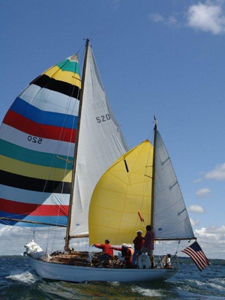
Crew "let's fly" Yankee's mizzen spinnaker, plus her main spinnaker, on a dash up Henderson Bay on Lake Ontario.
Abaco #102
We had an early launch on April 3rd and have been busy finishing our winter projects and fitting out Abaco for the upcoming season. After many years of planning and dreaming, we are finally setting sail in late May as retired cruisers! We plan to sail east thru southern New England, visiting friends all along the coast. By mid to late June we will head to Maine, eventually to cruise the Bay of Fundy to the St. John River. Depending on time and weather, we hope to head to Nova Scotia before heading back south. By early October we plan to reach the Chesapeake Bay, were we plan to make our new home in Oxford, MD. Hopefully, each year we will be able to head northeast in the spring and back south in the fall.
This past winter had no "major projects", but we did extensive refinishing of paint and varnish in the main cabin in preparation for "living aboard" this season. We finished our long days many times this winter with four or five different types of finish applied and all drying until our next coat. Fortunately the main boat shed at Cove Landing Marine proved to be a most hospitable place to accomplish this work, and we will miss having Abaco in the able hands of John and his small crew next winter. I am sure we will visit Hamburg Cove en route north and south each year, and hopefully some of our CT River friends will make their way to visit us on the Chesapeake.
Our only other additional projects (other than refinishing all exterior brightwork and having topsides and bottom painted) were replacement of the most outboard teak plank in the floor of the head, rebuilding and repainting the original Wilcox 1523 head, installing a Charles AC battery charger and a Raystar 125 GPS sensor (the latter deck mounted outboard the aft end of the port cockpit coaming on a "Cove Landing proper" mahogany base), and replacing the autopilot control head cockpit mounting block. We hope to see other Concordia owners in our travels downeast this season and would welcome any suggestions on anchorages (east of Roque) or other advice, especially on the St. John River. Abaco’s sail number is 10068, and we can be contacted via VHF 16 (or MMSI # 367381770), cell # 203-722-2779, or jcgoldweitz@gmail.com.
Fabrile #90
David Godine, Milton, MA
Fabrile is alive and well after two years in John Dunbar’s yard at Benjamin River. She’s had her planking redone and her ribs reglued and boasts a new 130% headsail and this year we took her out for over two weeks off the Maine coast. Managed to visit Isle au Haut, Isleboro, North Haven, Vinalhaven, Matinicus and Mohegan as well as attending the Dan Strohmeier celebration at "Base Camp Malay" as well as the Concordia birthday party in August. We also managed a few fine sails aboard "Owl" with our friend Jay Panetta.
Fabrile has been kept as close to "original" as possible - including the original Gray Marine, which still works just fine for our modest purposes. With the exception of one week in the total fog in July, we had some fine cruising all summer and look forward to sailing her back to her mooring off Bremen Long Island next June, where all Concordias are welcome to pick up our extra mooring on their way East or West in Maine. Hot meals and showers are provided gratis.
Java #1
Vagn & Sally Worm, Brooklin, ME
Nothing much to report for 2008 as JAVA only made a few day sails during the 2008 season. Much of this was due to the bad weather in both July and August in our area in Maine. JAVA did take part in the ERR finishing 11th in a real drifter with the course having to be shortened two times. This winter we are modifying our roller furling arrangement for our working jib which is set on a self-tacking jib club. The problem was that the sail set too full due to the extra line coming off the jib clew which acted as the outhaul to set the sail, as opposed to the usual set up when the sail is set by simply pulling on the sheet. Between the knot in the clew and a turning block at the boom end there was not enough room for the sail to be pulled out flat. To correct his problem we are putting a sheave at the clew of the jib (much like those on boats with in the mast furling mains), and changing out the boom end block for a sheave mounted on the outhaul fitting. This will give us the extra distance we need to flatten the sail as well as a two-part outhaul line. All of this of course, leads aft in the usual manner. A report on how it all worked out will follow.
W. & L. Howland Insurance Agency Inc.
962 Kempton St, New Bedford, MA 02740

The Insurance Agency Founded by Waldo & Llewellyn Howland
Insuring Concordias from the Very Beginning
Please call us for a quote or just to discuss your current coverage
The W. & L. Howland Insurance Agency, Inc. was founded in 1936 by Waldo and Llewellyn Howland to complement their growing boatyard, the Concordia Company.
Since that time we have been a "Marine Only" independent insurance agency providing our clients with knowledgeable, personal and professional handling of their Marine Insurance Business.
Telephone: 508-992-7731 or 1-800-848-7731
Fax: 508-997-0136
E-mail: yachts@WLHowland.com
Web: WLHowland.com
Coriolis #82
Douglas & Susan Adkins, Seattle, WA
My brief report for The Concordian concerns the escalating Bateka Wars being waged on both American Coasts. Owners of Concordia Yawls (and maybe even sloops) are entering into the Battle for The Bateka in record numbers.
Either restoring original boats, contracting for the building of new vessels, or building Batekas on their own, Concordians are lavishing untold time and attention to these lapstrake prams which originally could be supplied with our yachts as tenders.
Arvid Klein of Winnie of Bourne (No.11) is the proud owner of an original A&R Bateka, stalwart Concordian Rusty Aertsen is adding to his fleet of Snowbird (No.59) , Kestral (a Concordia 31) and Sandpiper (a Beetle Cat) with a Bateka newly built by the Concordia Company (and I'll bet it will sport an aviary name). Jeff Makholm of the famous bright 41 Arapaho is building a Bateka in his home in Boston and it is reportedly a beauty.
For our part, Coriolis awaits restoration of Abeking and Rasmussen Construction No. 4981, a Bateka built in 1954 for Priscilla ( No. 32) and later provided to Skye (No.40) as her tender. We were lucky to find the boat in Maine still owned by the Mcleod family long after selling Skye and we transported her across the country for a re-do, (we seem to have a habit of doing that!).
We have been working hard to put her back into shape, with some structural help from the talented Stewart McDougall of Kodama (No.46). A picture is enclosed showing our long time signpainter Dick Oshiro lettering her transom, inside and out. As you can see, she is named Perigee and when we are finished I will give a complete report including an admission of whether or not she actually holds water. She will have a few special flourishes so stay tuned.
Doug Adkins
Winnie of Bourne #11
John Arvid Klein & Cynthia Crimmins, Darien, CT
The Restoration of Winkle:
The notion of towing an inflatable behind Winnie of Bourne was anathema.
I contacted Jim Russell at IYRS, now at the New Bedford Whaling Museum, and he thought they had an A & R built Concordia designed Bateka pram somewhere in their holdings. He located it and for a modest donation it was ours. To undertake its restoration he suggested, amongst others, Tom Potter at The New England Shipyard. To assist in its restoration I was able to locate the original Concordia drawing at the Mystic Seaport Museum.
We had hoped to restore her to a bright finish but her 3/8" mahogany, clinker planked hull was too far gone and Tom could not guarantee reasonable seaworthiness. He suggested a long soak in a thin liquid epoxy. Her bow, transom and thwarts were replaced and many cracked ribs repaired. Her exterior was painted matching Winnie’s topsides; the interior above new floorboards was left bright. Shaw and Teney made some nice oars and we purchased a 2 HP Torqeedo electric outboard to assist us in adverse currents. She was also fitted with two pad eyes on her stern and Tom fabricated a three point lifting bridle that should make hoisting her somewhat easier.
The Concordia Yard is fabricating chocks as, happily, Peter Gallant in his meticulous restoration of Winnie reincorporated the original bronze fastening points on her cabin top. The photo indicates Concordia’s "dry fit" to determine the proper size of the chocks. All in all she is a delight, easy to row, easy to tow!
We will be doing the Monhegan Island Race this August and hope to see some additional Concordias and, maybe, Abaco.
John Arvid Klein
Arapaho #85
Jeff Makholm, Boston, MA
In the last Concordian, Brodie MacGregor reported that I said last fall, perhaps imprudently, that I planned to build my own Bateka this winter. I had seen the two unseaworthy A&R Batekas at Concordia last summer (of 1956 and 1962 vintages). They didn’t look too complicated, and I thought I could tackle such a project. The more I looked into it, however, the more complicated it became.
But Brodie said it, and Margo reprinted it. So I was committed. The first step was to secure the proper plans, as those two A&R Batekas were materially different from each other. Joe Callaghan went through the Concordia archives at Mystic Seaport and sent me the original 1950 plans by H. Miller Nichols, one of Concordia’s draftsmen mentioned in Waldo Howland’s book.
The shop? I expropriated the family room on the lowest level of our house in Boston’s South End, sheathed the whole thing in plastic, and got my various tools out of storage. I acquired and read a number of books on the subject of lapstrake construction. The most helpful to me were Howard Chapelle’s 1940 "Boatbuilding" and the paperback 1970 Wooden Boat publication "Building the Herreshoff Dinghy." Chapelle taught me lofting (and much else). The Herreshoff book detailed the methods of its builders during that yard’s heyday, which taught me how to make the thing. Bud McIntosh’s book on boatbuilding (Wooden Boat publication) taught me to approach the whole enterprise with good humor and not to pay too much attention to the experts.
I held assiduously to the Concordia plans, which called for White Cedar planking, White Oak transoms, frames, etc., Mahogany thwarts and rowlock pads and Hackmatack knees. It is all held together with bronze screws and copper rivets. The only waterproofing treatment, besides a close fit, is a strand of cotton caulking outside of where the planks fasten to the transoms. The only glue in the boat secured the tongue-in-groove transom planks together.
December was for lofting. Lofting has two ultimate goals—to make molds of the proper shape and to have a full-scale drawing from three intersecting perspectives to check, from time to time, how big the parts are and now they will line up. "Proper" is the watchword, for the measurements (the "offsets") on the plans of even such a skilled draftsman as Nichols are not free of mistakes. Diligent cross-referencing of measurements from the different drawn perspectives on the lofting floor smokes them out. Truly, however, lofting ceases to be something of a mystery only after you’re done with it. January was for building the molds and making the keel and keel apron. The proof of the pudding in lofting is whether the keel, cut from a pattern taken from the lofting, fits the set-up molds. It did. February was for making and attaching the planks—nine on each side. It was repetitive work—marking the spiling batten, transferring the spiled shape to the planking stock, sawing the plank from the stock, re-sawing the plank and planning the two halves to the required 5/16th thickness for each side. Some planks wouldn’t do—through mistakes in measurement, cracks or hidden defects in the stock or just bad luck. One just has to keep plugging away. But the whole house smelt wonderfully of cedar in the meantime. And I got very good with various planes—including keeping them very sharp.
March was for the ribs and interior fittings. Steamed White Oak has a somewhat acrid smell, but not unpleasant. The ribs are thin (5/16" x 5/8") but that wood is tough and hard to bend, particularly in a hurry (and you have about five seconds after removing a rib from the steam box before it begins to harden up—and lots of breakage because of "grain run-out" on those little things). Bending the 1 ¼" sheer clamps was the biggest bending job—very hard to do with only two hands. Steam box? A 10 foot, 4" pvc pipe attached to a common wallpaper steamer—very simple and very effective.
Oh, and I also got very good at riveting. The wee boat has about 900 of them of two different sizes. Riveting was the only thing I could not do entirely by myself, and finding helpers to hold the heavy bronze backing iron wasn’t easy. Finally, my 14-year-old son Daniel pitched in (he did very well on the per-rivet fee deal he made with me in my desperation!). The attached photo shows that the unvarnished boat, with thwarts, knees and floorboards, was essentially done by the end of March.
April is for varnishing. Now, the house shells like Epifanes and thinner and my shop’s days are numbered. Next comes fitting the gunwale guard, where the 1950 plans are suspiciously blank. I’ve got my own ideas. Then to see if the whole business actually floats. For those of you who don’t see ARAPAHO this sailing season—to see for yourselves—I’ll report in the Fall edition of the Concordian!
--Jeff Makholm
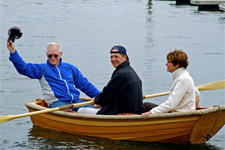
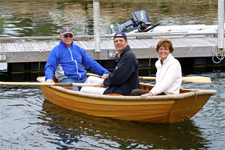
These pictures were received just as the newsletter was going to the printers and show Jeff Makholm's Bateka floats and rows beautifully.
Left to right: Tom, Jeff (smiling broadly), Cindy: Photo by Charlie Zarkadas
Pictures
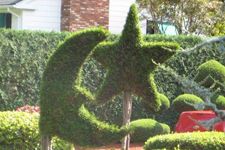
Concordia topiary from the 70th Anniversary Celebration, contributed by Karyn & Jeff Henschel of Whisper #56.
Concordias for Sale
| # | Name | Price | Broker | Phone |
|---|---|---|---|---|
| 1 | Java | $195,000 | Metinic Yacht Brokers | 207-326-4411 |
| 101 | Sea Hawk | $120,000 | Brooklin Boat Yard | 877-239-9208 |
| 44 | Lacerta | $110,000 | Concordia Company | 508-999-1381 |
| 3 | Halcyon | $34,000 | Sparkman & Stephens | 401-847-5449 |
| 86 | Dame of Sark | $230,000 | Dodson Boat Yard | 888-258-2957 |
| 92 | Savu | $150,000 | Concordia Company | 508-999-1381 |
| 21 | Streamer | $110,000 | Concordia Company | 508-999-1381 |
Miscellaneous News and Notes
- Copies of Elizabeth Meyer’s Concordia Yawls - The First Fifty Years are available through J Class Management and Amazon.com. Concordia owners ordering through J Class Management will receive a 25% discount. Contact Marcia Johnstone Whitney - mjw@jclass.com for ordering information.
- Congratulations to Jim Brown and SONNET and Laura and David McCurdy and ROWDY. There was a great picture of them in the December 2008 Cruising World.
- Your comments on the new format are appreciated. The newsletter will always be a work in progress, and as such, is open to change and continued improvement.
- Concordia-green corduroy is available through Soaring Heart Futon (Seattle) 206-282-1717.
- I have had a couple of requests to update information at www.concordiayawl.com and unfortunately I don’t have that ability. I haven’t had the password or login information in several years. Several years ago I paid a company to update the site and they basically just retyped it and made a lot of typos. When the site comes up for renewal, I will probably just drop it entirely.
- Deadlines continue to be April 15th for the spring newsletter and October 15th for the fall. This allows me approximately two weeks to organize the updates and pictures submitted, design the newsletter, proof and print. Please take a moment to mark your calendars.
- I am currently out of Concordia burgees, but when I get a couple of inquiries, I will reorder.
- Complete issues of the Concordian newsletter - Issues 1-47 (February 1986 to date) are available for $145. The newsletter collection spans 23 years and encompasses more history of the boats, projects, rebuilds, and travels than you can get anywhere else. Issues 37-47 are reprinted in full color.
- Thank you again to everyone who took care of their subscription renewals. Those funds received allowed me to send this issue to a local printer and future issues will continue in the upgraded format.



